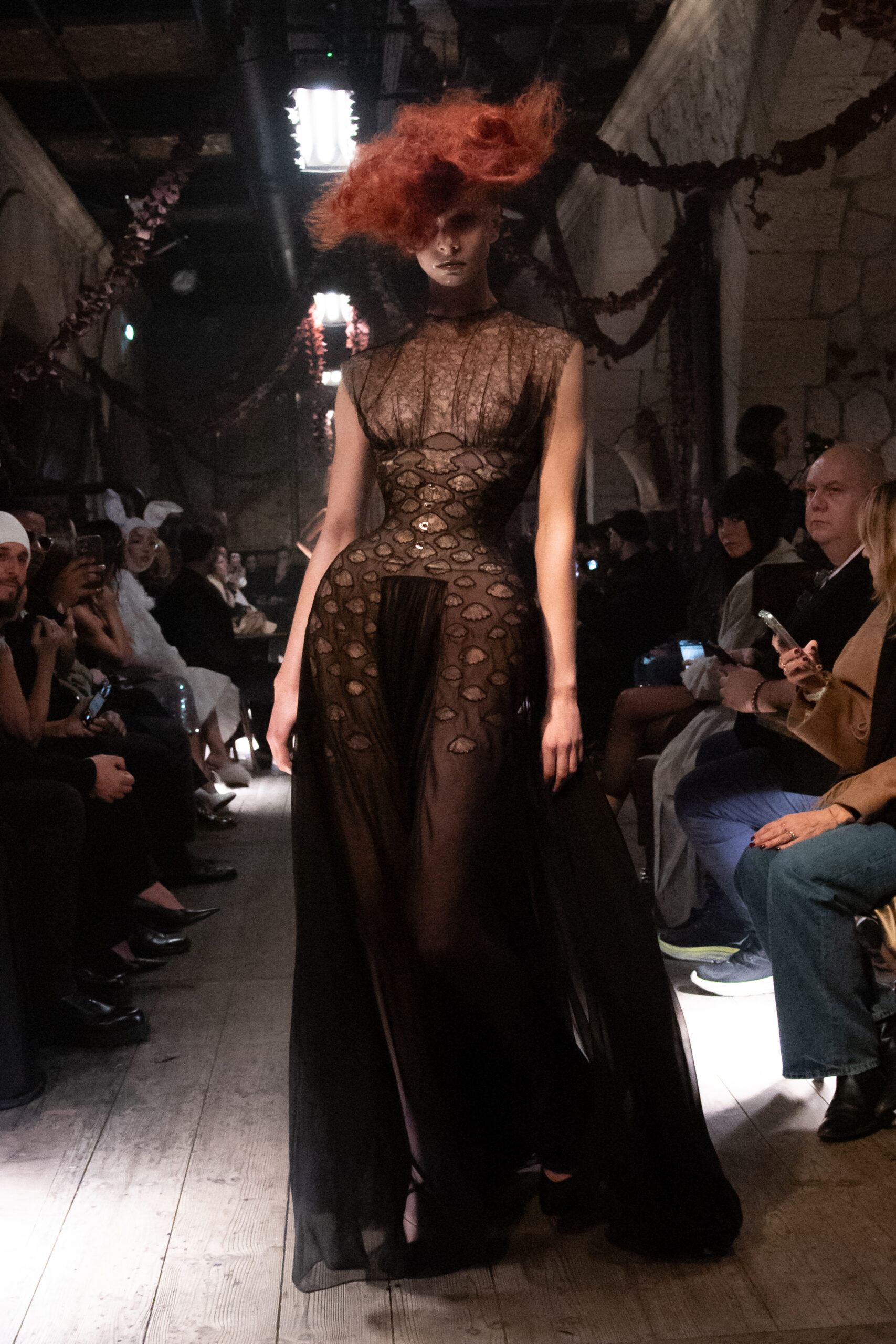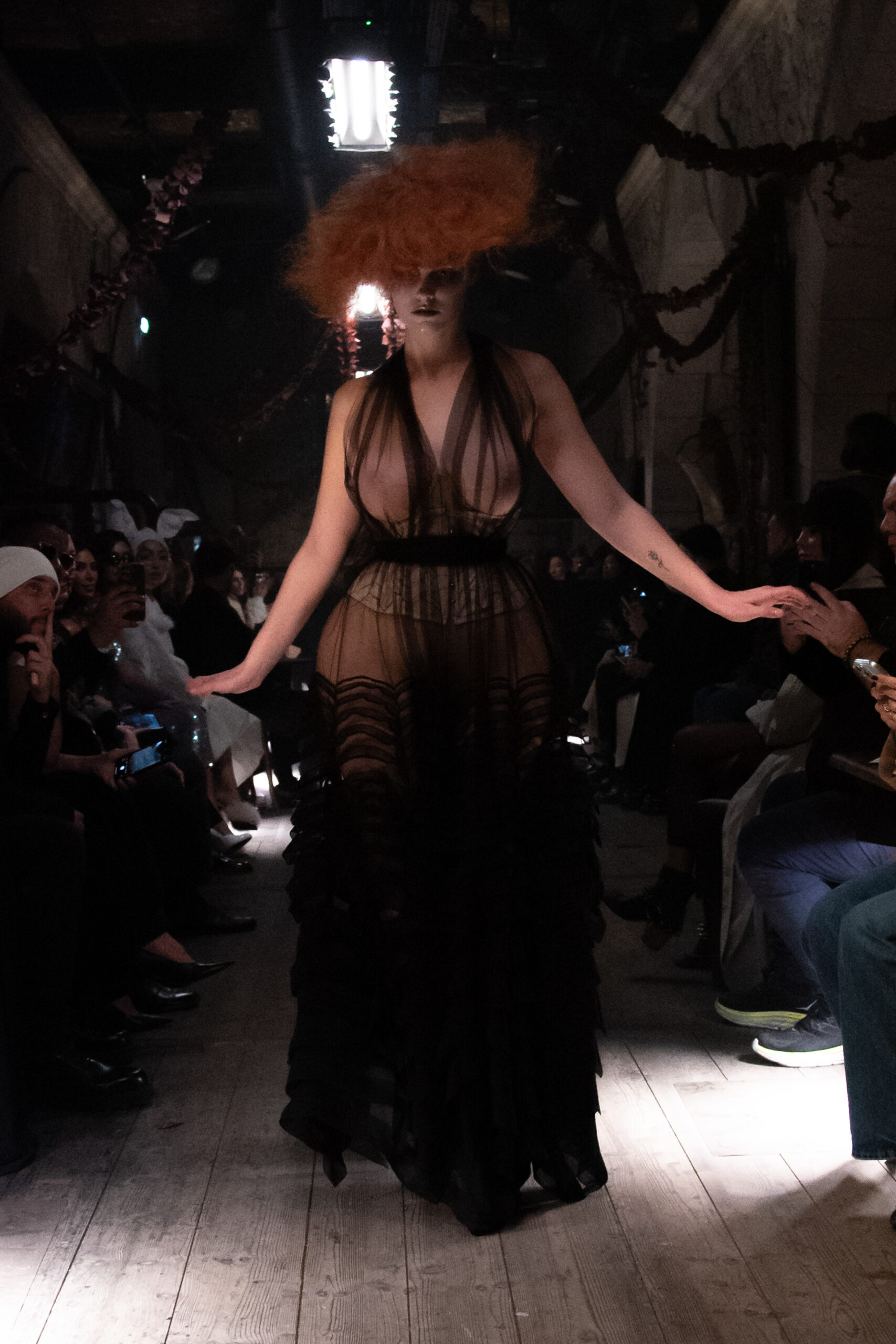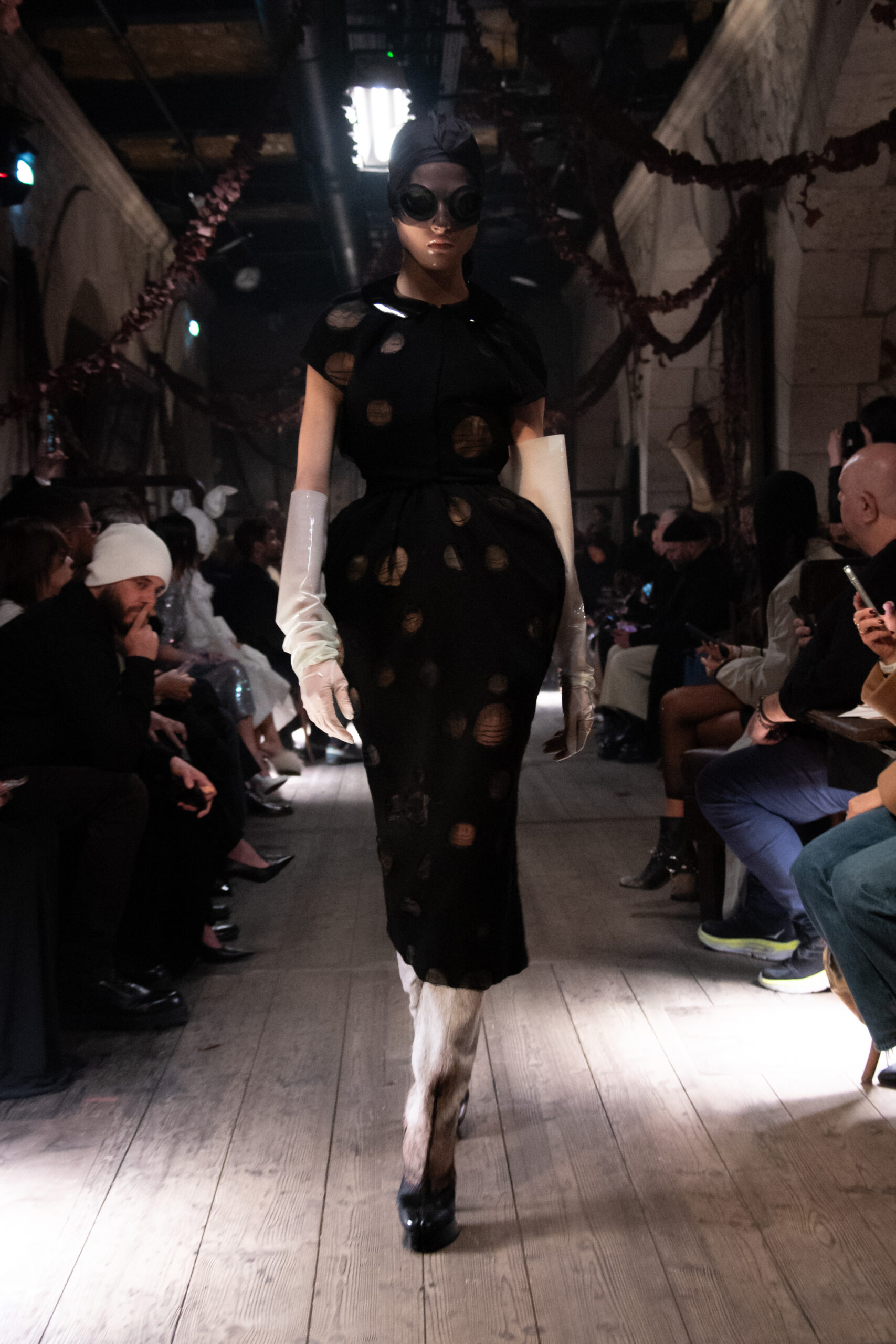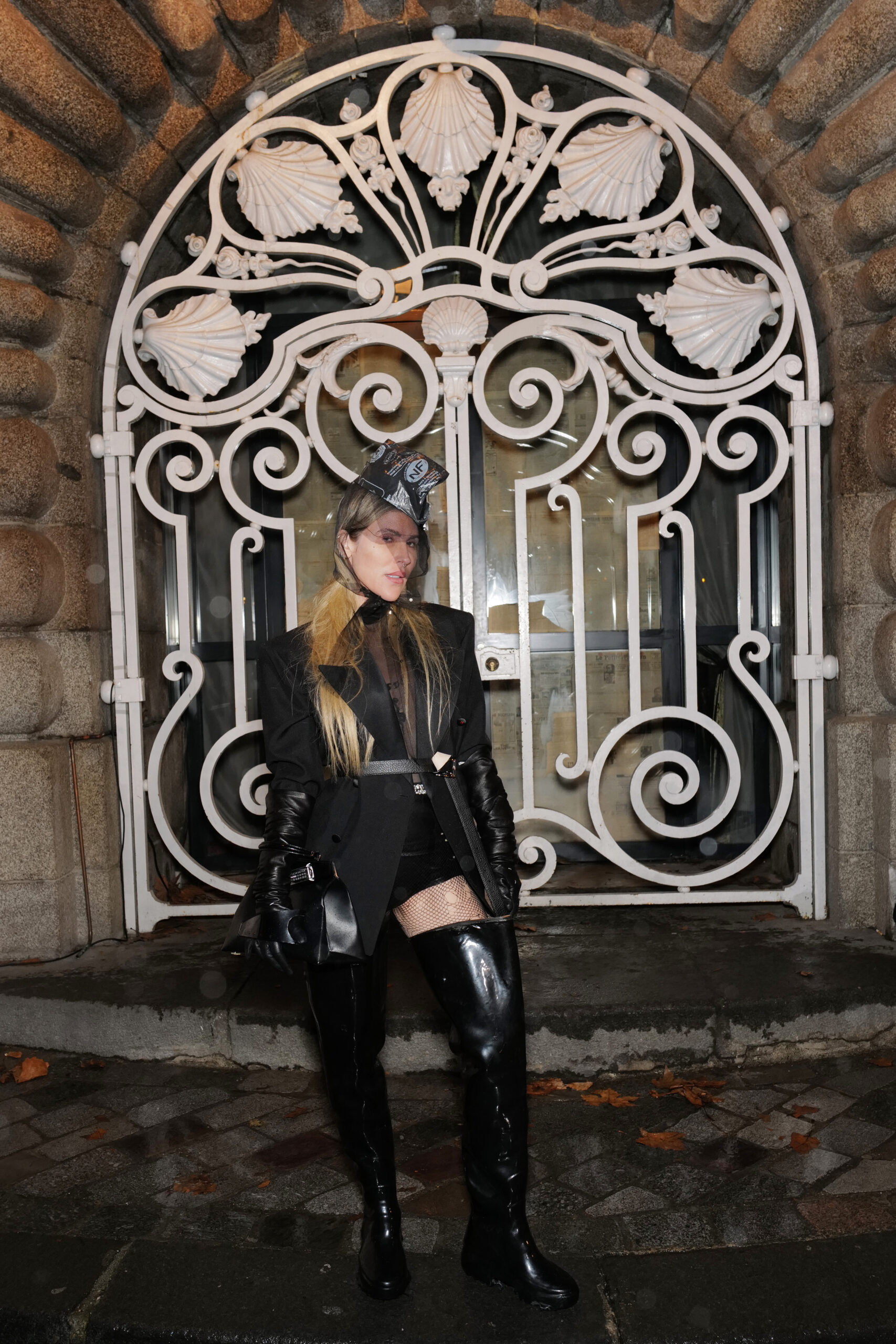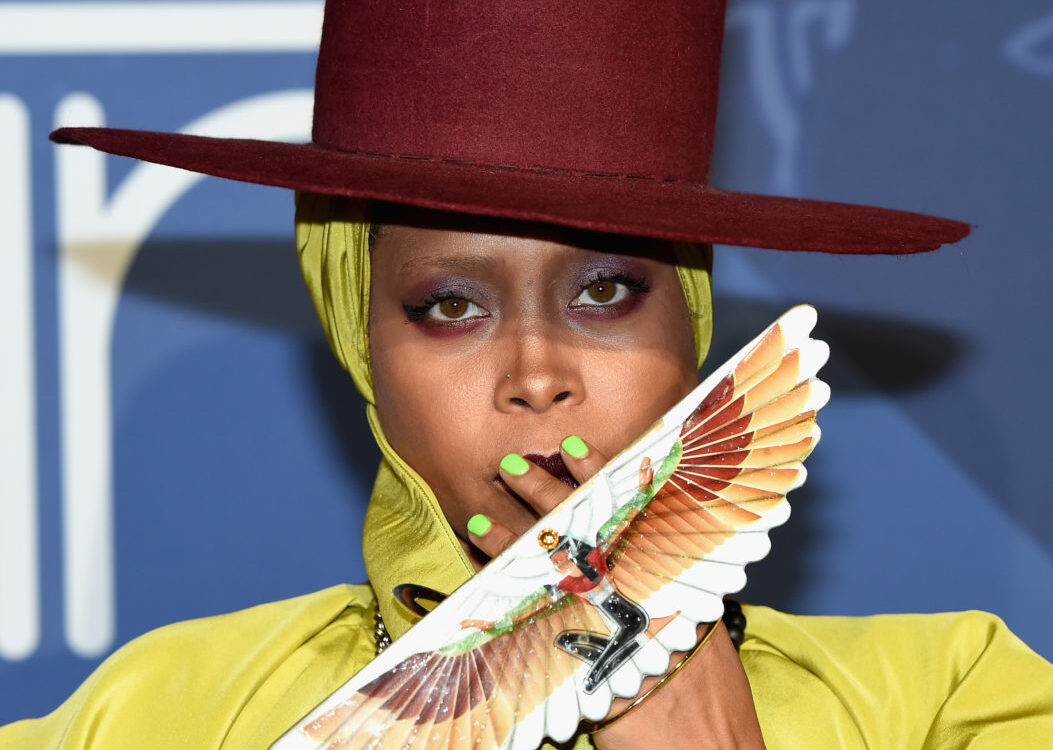Maison Margiela Artisanal 2024
The ritual of dressing is a composition of the self. With the body as our canvas, we build an exterior expressive of the interior: a form of emotion. The Maison Margiela 2024 Artisanal Collection paints a picture of the practices and occurrences that shape the character reflected within our dress. Borne out of an internal exploration founded in consciousness, it is a technical and philosophical study of presence and sentience.
Under Pont Alexandre III, bathed in the light of the first full moon of the year, Creative Director John Galliano captures a moment in time: a walk through the underbelly of Paris, offline. Intrigued by the voyeuristic portraiture of Brassaï, a focused awareness of our unnoticed surroundings unfolds: the night-time revellers one passes on a moonlit wander along the Seine, what lies beneath the imprints of their clothes, and what happens behind the dimly-lit windows of their homes. Presaged by a cinematic prelude seeped in the eerie, rainy ambience of Paris by night, the show manifests in a multi-disciplinary staging simultaneously filmed, edited and broadcast to physical and digital spectators. Would you like to take a walk with me, offline?
In a physical expression of emotional form, silhouettes are sculpted with body-modifying corsets and cinchers underpinned by prothèses. They create the framework for studies of the ritual of dressing explored through haute couture techniques reflected in the painter’s process, from line and shape to texture and value. Posing as heavy-duty wardrobe staples, featherlight jackets, coats and trousers are constructed through the technique of milletrage: a mirage created from a filtrage composed of a mille-feuille of organza and felt under a wool crêpe printed with a trompe l’oeil of the texture of a classic gentleman’s cloth. It is draped – aquarelled – in a voilette of tulle illusorily printed to appear moon-faded, sun-bleached, tobacco-stained or oily as if illumed by the reflection of water at night. Exercised through emotional cutting, the garments are imbued with the unconscious gestures that shape our expressions: a caban pulled over the head in the rain, a lapel raised to cover the face, a trouser hoicked up to evade a water puddle.
A reflection on the fragility of focus unfurls in dresses fashioned through forms of fade. Illustrating through painstakinghandwork the degeneration of detail that occurs when an image is imitated, thread-works of petals, godets, rosettes
and ruching degrade from bottom to top in expressions of retrograding: a figurative technique nodding at the idea of apparent lunar movement said to spin our energy inward and activate a deeper consciousness. Some interpretations materialise over bodysuits aquarelled in tulle in the fauvist grammar of the Dutch-French painter Kees Van Dongen. The practice also evolves in seamlace dresses constructed entirely and seamlessly from encrustations of lace. The collection’s synthesis between the painterly process and the ritual of dressing ignites a study of the muse-like relationship formed between artists and their anatomical lay dolls. It is conveyed in doll-like accents, in the stripetease of shirting dresses, and in tweed skirt-suits created through the new technique of rétrécirage which partly shrinks a garment to generate anatomical or coquettish expressions with illustrative shoulder lines. Created withChristian Louboutin, red-soled shoes sculpted with augmented heel caps and platforms echo the form language of the collection.
Techniques
Created over twelve months in the haute couture ateliers of Maison Margiela, the collection introduces several new techniques developed by John Galliano. It further evolves and refines established haute couture practices emblematic to the dressmaking of the Creative Director at the Maison.
Seamlace is a new technique signifying garments constructed entirely from encrusted fragments of lace or other
material decoupaged together, resulting in a completely seamless form like one big meandering embroidery. The collection’s seamlaced silhouettes include a dress with a papillon de nuit encrustation on the back crafted in velour, chiffon and georgette, clustered to the body like moths around a flame, and a dress encrusted from bugle-beaded panels dress evoking the light of the moon. Created by hand, these garments have been nine months in the making.
Milletrage – a portmanteau of mirage, mille-feuille and filtrage – is a new technique denoting featherlight garments posing as heavy-duty coats, jackets or trousers. Created from layers of fine lightweight fabrics, they are finished with a fabric printed in the trompe l’oeil of a classic menswear textile such as tweed, herringbone or coarse wool. Finally, they are aquarelled with a voilette of tulle printed to appear moon-faded, sun-bleached, tobacco-stained or oily as if illumed by the reflection of water at night. The practice reflects elements of the technique of projective filtrage – debuted in Autumn-Winter 2019 Artisanal Collection – wherein the impression of light projections on fabrics is adapted into actual prints on translucent materials, creating the illusion of projected imagery.
Retrograding is a new technique that embodies variations of thread-work, appliqué or encrustation – such as petals, godets, rosettes and ruching – which degrade from the bottom to the top of a garment. The practice illustrates the degeneration of detail that occurs when an image is imitated, or the linear base drawing of a painting that hasn’t yet been finished. Retrograding appears in long dresses, over bodysuits aquarelled in tulle in the grammar of Kees Van Dongen, and in seamlace dresses constructed entirely and seamlessly from encrustations of lace. As a nod to the collection’s moon-centric motifs, it is named from the astrological phenomenon of retrograde: the apparent lunar movement said to spin our energy inward and activate a deeper consciousness.


Emotional cutting is a new form of cutting which imbues a garment with the unconscious gestures that shape our expressions: a caban pulled over the head in the rain, a lapel raised to cover the face, a trouser hoicked up to evade a water puddle. The practice is employed in milletrage coats, jackets and trousers as well as caps. Evoked through techniques such as circular cutting (Artisanal Collection Autumn-Winter 2020), emotional cutting expands on the continuous gestural language of Maison Margiela including dressing in haste (Artisanal Collection
Autumn-Winter 2017), the bourgeois gesture (Artisanal Collection Spring-Summer 2020) and unconscious glamour (Artisanal Collection Spring-Summer 2017).
Aquarelling is a new term used for the draping of tulle or muslin in the same way a painter works with watercolours. Employed in milletrage and retrograding garments, it is loosely related to the wet look and circular cutting techniques
first featured in the Autumn-Winter 2020 Artisanal Collection: disruptive senses of draping, which can assimilate the impression of fabric soaked in water, and make muslin, tulle or thermocollant appear as if they are clinging to the skin like the wet-drapery genre of sculpture.
Rétrécirage is a new cutting-edge technique in which a tweed garment is strategically placed with elements of glue and fine wool crêpe which shrink the cloth when boiled, and suppresses the volume into a specific shape. Through this process, anatomical or coquettish sweetheart shapes take form in tailored silhouettes, framed by an illustrative shoulder line. Rétrécirage – derived from the French term for shrinking – is employed in tweed jackets and skirt-suits, some constructed inside-out.
Stripe-tease is the new technique of ‘closing’ the negative lines of a striped material to form a colour-blocked entity, enabled by the sculpted form on which the garment is created. The practice is exercised in sundresses and blouses in blue-and-white-striped cotton poplin, fitted on corseted silhouettes.
Gouttoir-coating is a new technique applied to garments in which seeping silicone treatments as well as hand-beaded crystals are made to look as if umbrellas, hats, coats and jackets have been rained on or as if trouser hems have been dragged through puddles of rainwater.
Rorschach dotting, debuted in the Spring-Summer 2024 Co-Ed Collection, is a pareidolic form of cutting derived from the technique of Rorschach cutting first featured in the 2023 Co-Ed Collection. The dot-shaped patterns are formed from cuts that evoke the outlines of familiar animated characters or iconographic silhouettes known to us all. Hinting at moth holes, the technique appears in a wool devoré caped-back dress.
Reverse swatching is a method which exchanges the fabrics traditionally used for certain parts of dressmaking with materials of a contrasting value, such as haute couture constructions created in humble foam. Echoing the Maison Margiela philosophy of appropriating the inappropriate, the practice was introduced in the Autumn-Winter 2018 Artisanal Collection. It is employed in jackets, skirts and hats crafted in black gloss-coated lace and white foam.
Caisetting is a technique in which fine materials like silk organza and crin are ridged and grooved to resemble orrugated cardboard. Debuted in the Autumn-Winter 2017 Artisanal Collection as part of the Maison Margiela notion of new glamour – the elevation of simple or habitual materials through the familiar language of glamour – the technique evolves in a skirt, dress and cape where motifs hand-cut into the caisetted texture evoke the memory of certain imagery or other garments.
The memory of illustrates the languished impression of a familiar motif still evident – either visibly or emotionally – within a garment, an accessory, or a piece of jewellery. Introduced in the Autumn-Winter 2017 Artisanal Collection, it a key technique and philosophy in the practice of John Galliano. It appears in many forms and ambiences throughout the collection, including in caisetted garments cut with the memory of other garments and in the memory of trousers transformed into skirts.
Fabric sequins take shape in the all-over hand-cut scalloping of a garment, which creates flickering holes that interact with its lining. Introduced in the Spring-Summer 2020 Artisanal Collection, the technique evolves with electrically winking effect in a shadow-green silk-velvet bias-cut column dress.
Abstract lace is a technique through which a garment is evenly riddled with hand-cut holes as a deconstructive interpretation of polka dots, effectively creating an abstraction of lace. First featured in the Autumn-Winter 2019 Artisanal Collection, the practice is amplified in silk organza and silk muslin blouses.
Bias cutting appears throughout the collection. The technique materialises in fabric cut at an angle, allowing the natural elasticity of the cloth to hit the bias. Contrary to cutting straight-of-grain, bias cutting creates a languid and mercurial garment, which generates a harmonious and dynamic exchange between fabric and body. The result is a liberating and non-constricting sense of movement. It is a dressmaking practice central to the creative expression of John Galliano.
Materials
Milletrage coats, jackets and trousers are crafted in silk organza, crin and felt with top layers of wool crêpe posing as the humble cloths of the classic gentleman’s wardrobe. They are aquarelled in tulle, which appears throughout the collection. Retrograded dresses take form in silk tulle or muslin with thread-work or appliqués in georgette, chiffon, velvet and satin. Seamlace dresses are encrusted from Chantilly lace or embellished with bugle beads. Rétrécirage skirt suits are crafted in boiled tweed with elements of wool crêpe. Stripe-tease sundresses and blouses are created in the cotton poplin native to shirting. Rorschach-dotted cloth materialises in wool devoré. Caisetted garments are fashioned from silk organza and crin. Fabric sequins are cut from silk velvet. Abstract lace blouses manifest in silk organza and silk muslin. Trouser-suits feature in wool and barathea. Cinchers are constructed in silk satin or leather along with corsets, which also take shape in calico, in jersey matched to the skin of the muse, in repurposed antique brocades, and in the cotton poplin of stripe-tease adaptations. Prothèses are cast in silicone. Breastplates are moulded in wood- or porcelain-imitation leather. Muses wear sheer undergarments by Cadolle, the lingerie purveyor founded by Herminie Cadolle, who invented the brassiere – then known as the ‘corselet-gorge’ – in 1889.
Palette
The black-and-white photography of Brassaï informs a palette founded in the moonlit streets of Paris, the slick surface of the Seine by night, and the reflection of the city lights in the steely shades of rainwater puddles. Navy and midnight blue blend with the evening sky. Colours faded by the metallic light of the moon or deepened by the darkness of shadows manifest in the blacks, greys, anthracites, browns, dark green and beige of the classic gentleman’s wardrobe, complemented by the light blue of shirting cloths. They are contrasted by the glamour of boudoir colours and powdery nuances, from the lavender, lilac and heather of dresses and skirt suits to the pale pink of dresses and undergarments. The tulle voilettes of illusionary coats, jackets and trousers are printed in colours resembling the fade
of the moon, the bleach of the sun, the stains of tobacco, or the oiliness of the water’s reflection at night. Bodysuits, masks and pumps are aquarelled in the fauvist colour language of the Dutch-French painter Kees Van Dongen.
Accessories
Hats in gloss-coated foam, chiffon and muslin enveloped in stocking material echo the reverse swatching of the garments with which they are worn. Caps imbued with the gestures of emotional cutting are crafted in the cloths of the gentleman’s wardrobe or in the printed trompe l’oeil wool crêpes of the collection’s milletrage garments. Appropriating the inappropriate, goggles and goggled turbans appear in silk organza with elements of clear material. Masks are aquarelled from tulle and embroidered with face motifs. Moulded loups are created in collaboration with
Stephen Jones. Moulded leather breastplates pose as porcelain and wood. A deconstructed black nylon umbrella with a snakeskin handle is adorned with seeping silicone gouttoir coating. Ankle bracelets are composed of wristwatches
and strings of pearls. Muses carry small top-handle Snatched created in an origami manner from single pieces of leather or fabric, some in rétrécirage tweed. They are enveloped in stocking materials encased with pearl necklaces.
Shoes
For the 2024 Artisanal Collection, Maison Margiela collaborates with Christian Louboutin on shoe designs fusing the iconography of the two houses. Conceived in an artistic exchange between Creative Director John Galliano and Christian Louboutin, the six haute couture silhouettes are founded in the ritual of dressing. They feature the shoe designer’s emblematic red sole.
Pumps crafted with the Tabi split-toe adapt the body-modifying langauge of the collection in magnified platforms and prothèse-augmented heel caps evoking the outline of hoofs. Set on a 12-cm heel, the pumps feature in black, white or beige leather and emerald velour. The design evolves into Tabi two-piece heels with a classic ankle-strap in black neoprene or pink or emerald velour and faux lizard, and Tabi two-piece heels with an interlaced ankle-strap in black neoprene or velour and faux lizard in yellow, emerald or Eau de Nil. Likewise crafted with prothèse-augmented heel caps and magnified platforms, Tabi knee-high boots in ponyskin interpret the retrograding central to the collection. Here, the reverse degradé of the technique is employed through hand-painting to evoke an animal-like sensibility. Informed by silhouettes worn by policemen around the mid-century, Tabi lace-up derbies appear in black leather or leopard-printed neoprene, and Tabi lace-up boots and Tabi brogue boots materialise in black leather or black croc-embossed leather. The cinematic prelude features an interlaced ankle-strap pump constructed as a sole-less standalone stiletto heel.
Photocall & Front Row:
- Maison Margiela Artisanal 2024 Araya Hargate
- Maison Margiela Artisanal 2024 Ella Richards
- Maison Margiela Artisanal 2024 Jennifer Grace
- Maison Margiela Artisanal 2024 Nadia Lee Cohen
- Maison Margiela Artisanal 2024 Brenda Weischer
- Maison Margiela Artisanal 2024 Francesca Haywards
- Maison Margiela Artisanal 2024 Jun Jong Seo
- Maison Margiela Artisanal 2024 Noah Cyrus
- Maison Margiela Artisanal 2024 Christian Louboutin
- Maison Margiela Artisanal 2024 Jazzelle
- Maison Margiela Artisanal 2024 Marguerite Thiam
- Maison Margiela Artisanal 2024 Tommy Cash
- Maison Margiela Artisanal 2024 Bryant Giles
- Maison Margiela Artisanal 2024 Guillaume Diop
- Maison Margiela Artisanal 2024 Kat Zhang
- Maison Margiela Artisanal 2024 Saint Jhn



